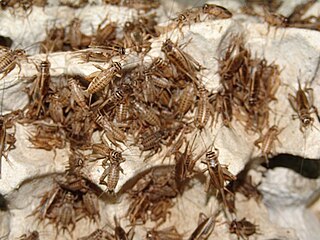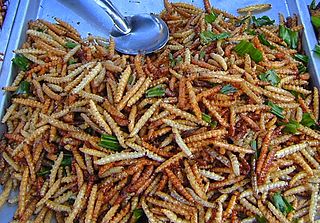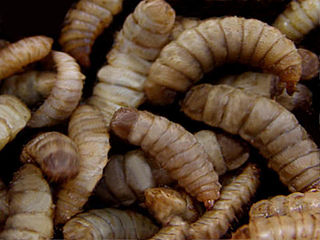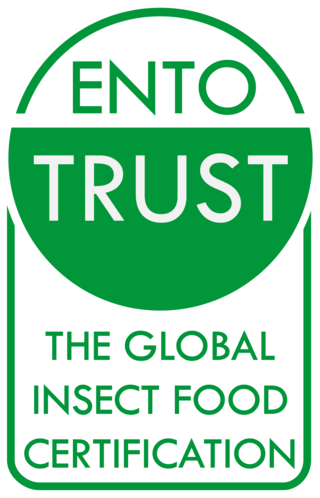
Mealworms are the larval form of the yellow mealworm beetle, Tenebrio molitor, a species of darkling beetle. Like all holometabolic insects, they go through four life stages: egg, larva, pupa, and adult. Larvae typically measure about 2.5 centimetres (0.98 in) or more, whereas adults are generally 1.25 to 1.8 centimetres in length.

The migratory locust is the most widespread locust species, and the only species in the genus Locusta. It occurs throughout Africa, Asia, Australia and New Zealand. It used to be common in Europe but has now become rare there. Because of the vast geographic area it occupies, which comprises many different ecological zones, numerous subspecies have been described. However, not all experts agree on the validity of some of these subspecies.

Gryllinae, or field crickets, are a subfamily of insects in the order Orthoptera and the family Gryllidae.

Entomophagy in humans or human entomophagy describes the consumption of insects (entomophagy) by humans in a cultural and biological context. The scientific term used in anthropology, cultural studies, biology and medicine is anthropo-entomophagy. Anthropo-entomophagy does not include the eating of arthropods other than insects such as arachnids and myriapods, which is defined as arachnophagy.
Cricket-spitting is a sport wherein contestants place a dead cricket in their mouth, and then spit it as far as they can. The contestant who can spit the cricket the farthest is declared the winner.

Live food is living animals used as food for other carnivorous or omnivorous animals kept in captivity; in other words, small preys fed alive to larger predators kept either in a zoo or as a pet.

Crickets are orthopteran insects which are related to bush crickets, and, more distantly, to grasshoppers. In older literature, such as Imms, "crickets" were placed at the family level, but contemporary authorities including Otte now place them in the superfamily Grylloidea. The word has been used in combination to describe more distantly related taxa in the suborder Ensifera, such as king crickets and mole crickets.

Iflaviridae is a family of positive sense RNA viruses insect-infecting viruses. Some of the insects commonly infected by iflaviruses include aphids, leafhoppers, flies, bees, ants, silkworms and wasps. The name "Ifla" is derived from the name "Infectious flacherie virus", a member species. There is one genus (Iflavirus) and 16 species in this family.

Insect farming is the practice of raising and breeding insects as livestock, also referred to as minilivestock or micro stock. Insects may be farmed for the commodities they produce, or for them themselves; to be used as food, as feed, as a dye, and otherwise.

Insects as food or edible insects are insect species used for human consumption. Over 2 billion people are estimated to eat insects on a daily basis. Globally, more than 2,000 insect species are considered edible, though far fewer are discussed for industrialized mass production and regionally authorized for use in food. Many insects are highly nutritious, though nutritional content depends on species and other factors such as diet and age. Insects offer a wide variety of flavors and are commonly consumed whole or pulverized for use in dishes and processed food products such as burger patties, pasta, or snacks. Like other foods, there can be risks associated with consuming insects, such as allergic reactions. As commercial interest in insects as food grows, countries are introducing new regulatory frameworks to oversee their production, processing, marketing, and consumption.

Keeping crickets as pets emerged in China in early antiquity. Initially, crickets were kept for their "songs" (stridulation). In the early 12th century the Chinese people began holding cricket fights. Throughout the Imperial era the Chinese also kept pet cicadas and grasshoppers, but crickets were the favorites in the Forbidden City and with the commoners alike. The art of selecting and breeding the finest fighting crickets was perfected during the Qing dynasty and remained a monopoly of the imperial court until the beginning of the 19th century.
Cricket paralysis virus (CrPV) is a paralytic disease affecting crickets. It was initially discovered in Australian field crickets by Carl Reinganum and his colleagues at the Victorian Plant Research Institute. The disease spread rapidly through a breeding colony as well as through a laboratory population causing about 95% mortality. This was the first recorded isolate of the virus and is generally referred to as CrPVvic to distinguish it from subsequent isolates.

Alphitobius diaperinus is a species of beetle in the family Tenebrionidae, the darkling beetles. It is known commonly as the lesser mealworm and the litter beetle. It has a cosmopolitan distribution, occurring nearly worldwide. It is known widely as a pest insect of stored food grain products such as flour, and of poultry-rearing facilities and it is a vector of many kinds of animal pathogens. In larval form, it is an approved novel food in the European Union, and also used as animal feed.

The welfare of farmed insects concerns treatment of insects raised for animal feed, as food or pet food, and other purposes such as honey and silk.
Cricket flour is a protein-rich powder made from crickets, using various processes. Cricket flour differs from true flours made from grains by being composed mainly of protein rather than starches and dietary fiber.
Insect-based pet food is pet food consisting of, or containing insects digestible by pets such as dogs or cats. A limited, but growing number of products are available on the market, including insect-based cat food, dog food, and pet treats.

Insects as feed are insect species used as animal feed, either for livestock, including aquaculture, or as pet food.

Entomophagy is the practice of eating insects. An alternative term is insectivory. Terms for organisms that practice entomophagy are entomophage and insectivore.

The Entotrust certification is a voluntary product certification of insects as food, and related insect-based foods, which allows producers to communicate their food safety and sustainability. Increasingly used, in Europe, Africa, Asia, US, Mexico, and Latam with the mission to recognize and report quality products based on edible insects, the logo can only be used by fully certified producers and farmers.
















